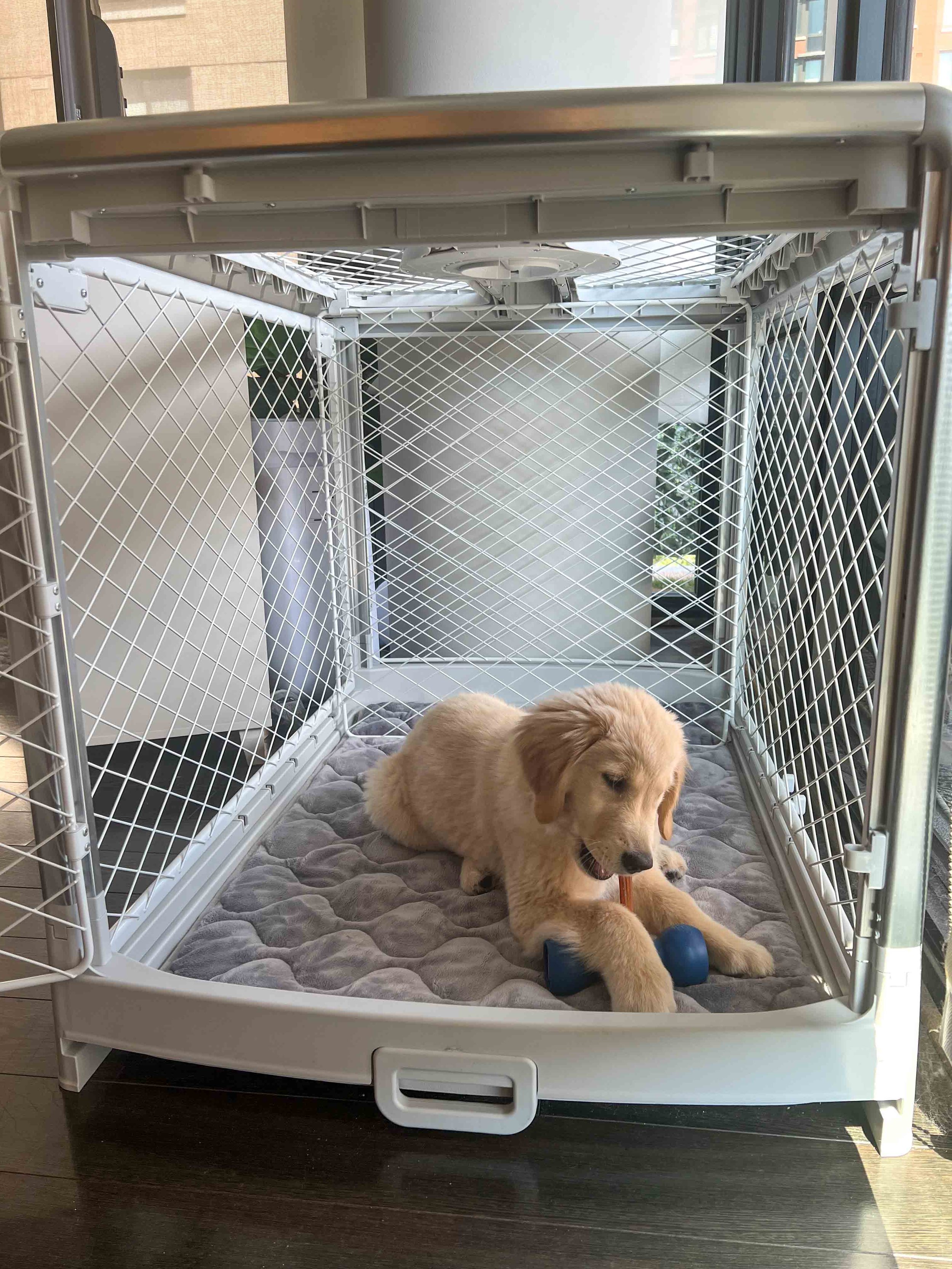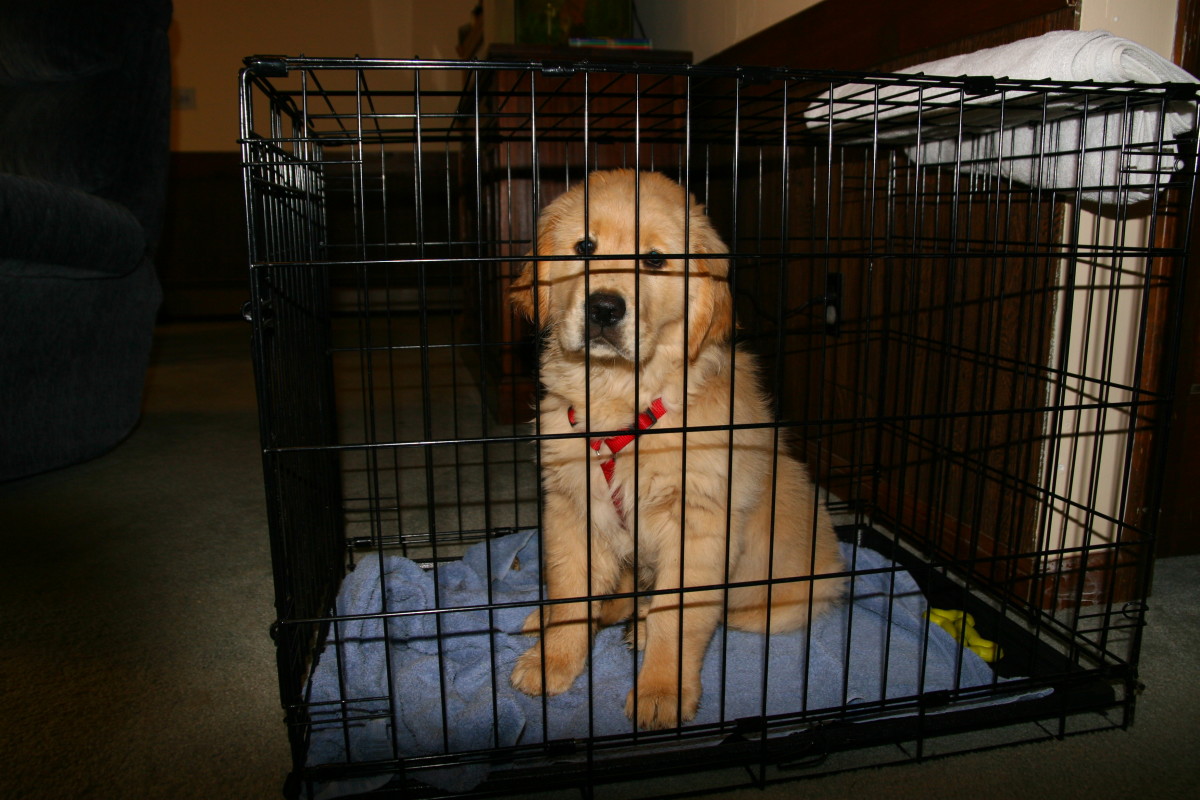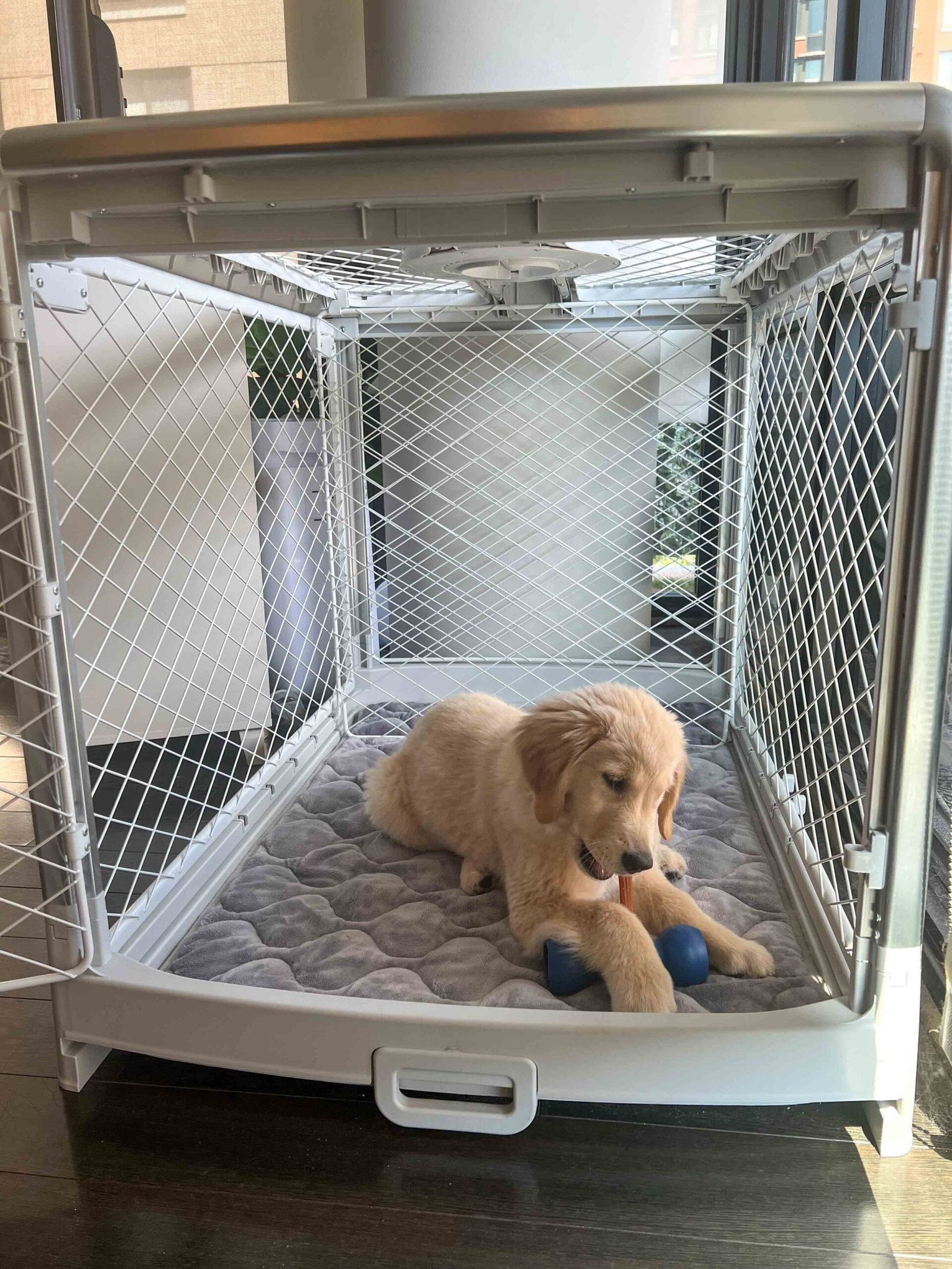Are you wondering how long you can leave your beloved golden retriever in a crate? Well, let’s dive into this important topic so you can be confident in providing the best care for your furry friend! Golden retrievers are known for their friendly nature and need for companionship, but crate training can be a helpful tool when it comes to their safety and well-being.
Now, you might be thinking, how long can my golden retriever stay in a crate without feeling uncomfortable or stressed? The answer depends on various factors such as age, physical health, and training progress. Puppies generally have less bladder control and need more frequent bathroom breaks, while adult dogs can hold it in for longer periods.
Remember, it’s crucial to provide regular exercise, mental stimulation, and social interaction outside of crate time. Dogs are social animals, and they thrive on human companionship and meaningful interactions. So, let’s find the sweet spot where your golden retriever feels comfortable and secure in their crate without spending excessive amounts of time confined.
In this article, we’ll explore the recommended crate durations for golden retrievers of different ages, helpful tips for crate training success, and signs that your furry friend may need a break from their crate. Stick around, and let’s make crate time a positive and enjoyable experience for you and your golden retriever!

How Long Can a Golden Retriever Be in a Crate?
Being a responsible pet owner involves ensuring the safety and comfort of your furry friend. If you have a golden retriever, you might be wondering how long they can safely stay in a crate. Crates can serve as a useful tool for training, providing a secure space, and preventing destructive behavior. However, it is essential to strike a balance and not keep your golden retriever confined for too long. In this article, we will explore the appropriate duration for crate time, the benefits of crate training, and tips for making crate time more enjoyable for your golden retriever.
The Benefits of Crate Training for Golden Retrievers
Crate training can offer numerous benefits for your golden retriever. It provides them with a safe and comfortable den-like space that they can call their own. Here are some advantages of crate training:
1. Security and Safety:
A crate can provide a sense of security and safety for your golden retriever. It helps create a designated space where they can relax and feel protected. Crates are especially useful during house training and when you need to leave your golden retriever unsupervised for short periods.
When crate training your golden retriever, ensure that the crate is large enough for them to stand, turn around, and lie down comfortably. It should also have proper ventilation and be equipped with a soft bedding for added comfort.
2. Preventing Destructive Behavior:
Golden retrievers are known for their energetic and curious nature. However, this can sometimes lead to destructive behavior, such as chewing on furniture or other household items. Crate training can help prevent such behavior by providing a controlled environment where they can’t access things they shouldn’t.
When leaving your golden retriever in the crate, make sure to provide them with toys or puzzle feeders to keep them mentally stimulated. This will help prevent boredom and reduce the chances of them resorting to destructive behavior.
3. Aid in Housetraining:
Crate training can be instrumental in housetraining your golden retriever. Dogs have a natural instinct to keep their sleeping area clean, and crates can help reinforce this instinct. By confining your golden retriever to a crate when you cannot supervise them, you can prevent accidents and create a routine that promotes successful housetraining.
Remember to take your golden retriever outside to their designated potty area immediately after letting them out of the crate. This will help reinforce the association between going outside and relieving themselves.
4. Facilitate Travel and Vet Visits:
Having a crate-trained golden retriever makes traveling and vet visits much more manageable. Crates offer a familiar and secure space for your dog, reducing stress and anxiety during car rides or trips to the veterinarian. Crate training also allows your golden retriever to ride safely in the car, preventing them from wandering and causing potential distractions.
Introduce your golden retriever to the crate gradually, making it a positive and comfortable experience. Provide treats, toys, and praise when they enter the crate willingly. This will help create positive associations and make crate time a pleasant experience for your furry friend.
Tips for Making Crate Time Enjoyable for your Golden Retriever
Making crate time enjoyable for your golden retriever is crucial for their well-being. Here are some tips to help make crate time a positive experience:
1. Introduce the Crate Gradually:
When starting crate training, it’s essential to introduce the crate gradually and in a positive manner. Allow your golden retriever to explore the crate on their own terms, placing treats and toys inside to encourage them to enter willingly. Avoid forcing them into the crate or using it as a form of punishment.
Start by leaving the crate door open and gradually increase the duration your golden retriever spends inside. Eventually, they will associate the crate with positive experiences and willingly enter it when needed.
2. Create a Positive Association:
Make the crate a positive and rewarding place for your golden retriever. Use treats, praise, and toys as rewards for entering and staying in the crate. This will help build a positive association and make your furry friend view the crate as their safe and cozy space.
Consider feeding your golden retriever their meals in the crate, further reinforcing the positive association. You can also provide them with special toys or interactive feeders that they only have access to inside the crate. This will keep them mentally stimulated and occupied during crate time.
3. Gradually Increase the Duration:
When crate training your golden retriever, it’s important to start with short durations and gradually increase the time. Begin by confining them to the crate for a few minutes and slowly extend the duration. Building up their tolerance to being in the crate for longer periods will help prevent anxiety and make crate time more comfortable for your golden retriever.
Ensure that you provide plenty of exercise and mental stimulation before crate time. A tired golden retriever is more likely to settle down and rest in the crate without becoming agitated or anxious.
4. Use Positive Reinforcement:
Consistency and positive reinforcement are key when crate training your golden retriever. Reward them with treats and praise every time they willingly enter the crate. Use a cue word or phrase, such as “crate time” or “go to bed,” to signal to your golden retriever that it’s time to go into the crate.
Avoid letting your golden retriever out of the crate when they are barking or whining, as this will reinforce the behavior. Instead, wait for a moment of calmness or silence before opening the crate door. This teaches them that quiet behavior is rewarded with freedom.
In conclusion, crate training can be a beneficial tool for golden retrievers, providing them with security, comfort, and aiding in their training. However, it’s important to strike a balance and not keep them confined for extended periods. Gradually increase the duration of crate time, create positive associations, and make crate time enjoyable for your golden retriever. With the right approach, crate training can be a positive experience for both you and your furry friend.
Key Takeaways: How long can a golden retriever be in a crate?
- A golden retriever should not be left in a crate for more than 4-6 hours at a time.
- Crates should be used as a training tool and not as a long-term confinement solution.
- It’s important to provide regular exercise and mental stimulation to prevent boredom and restlessness.
- Proper crate size and comfort are essential for a happy and comfortable golden retriever.
- If you need to leave your golden retriever alone for longer periods, consider alternate solutions like doggy daycare or hiring a dog sitter.
Frequently Asked Questions
Are you wondering about how long you can leave your beloved golden retriever in a crate? We’ve got you covered! Here are some common questions and answers to help you understand the best practices for crate time with your furry friend.
1. How long can a golden retriever be in a crate?
It’s important to remember that crate time should be limited to ensure your golden retriever’s well-being. A general rule of thumb is that adult golden retrievers can be crated for up to 6-8 hours, while puppies should not exceed 3-4 hours. This ensures they have enough time outside of the crate for exercise, bathroom breaks, and socialization.
However, every dog is different, and individual needs may vary. If your golden retriever is exhibiting signs of distress or discomfort, it’s crucial to adjust their crate time accordingly. Gradually increase the duration as your dog becomes more comfortable, always monitoring their behavior and providing them with plenty of mental and physical stimulation outside of the crate.
2. What can happen if a golden retriever is left in a crate for too long?
Leaving a golden retriever in a crate for an extended period can have negative consequences on their physical and mental well-being. Dogs are social animals and need regular human interaction, exercise, and mental stimulation. If they’re confined to a crate for too long, they may experience anxiety, depression, restlessness, and even physical health issues like muscle atrophy or bladder problems.
To avoid these problems, it’s crucial to provide your golden retriever with ample opportunities for exercise and mental enrichment outside of the crate. Regular playtime, walks, training sessions, and socialization with other dogs or humans are essential for their overall happiness and well-being.
3. How can I make crate time more pleasant for my golden retriever?
Creating positive associations with the crate can help make crate time a more pleasant experience for your golden retriever. Start by gradually introducing them to the crate, allowing them to explore it willingly, and offering treats and praise when they enter voluntarily. Make the crate cozy with comfortable bedding and toys to keep them entertained.
It’s also essential to establish a consistent crate routine. Use the crate for short periods initially while you’re around, gradually increasing the duration. Provide mental stimulation through puzzle toys or treats, and reinforce good behavior with rewards. Ensure the crate is never used as a form of punishment, as it should be a safe and positive space for your furry friend.
4. Can a golden retriever be crated overnight?
Yes, golden retrievers can be crated overnight, but it’s essential to consider their individual needs. Puppies may need to go outside for bathroom breaks during the night, and it’s crucial to accommodate those needs. Ensure the crate is comfortable, with enough space for your golden retriever to stretch and turn around. Provide water outside the crate, and take them outside for a potty break before bedtime.
Remember, crate time during the night should be balanced with sufficient daytime exercise and mental stimulation. Gradually increase overnight crate time as your golden retriever becomes accustomed to it, ensuring they continue to feel safe and secure while sleeping.
5. Can a golden retriever be crated while I’m at work?
While it’s possible to crate a golden retriever while you’re at work, it’s important to ensure they are not spending an excessive amount of time in the crate. Adult golden retrievers can handle being crated for 6-8 hours, but it’s crucial to provide plenty of exercise, mental stimulation, and attention before and after work hours. Puppy golden retrievers, being more active, should not be crated for more than 3-4 hours at a time.
If you work long hours, consider hiring a dog walker or utilizing doggy daycare services to break up the day for your golden retriever. Leaving them with interactive toys, puzzle feeders, or frozen Kongs can also help keep them mentally stimulated while you’re away. Remember, a well-exercised and mentally engaged golden retriever is more likely to be content in their crate while you’re at work.

I Wish I Knew THIS Before Getting A Golden Retriever Puppy
Summary
Being in a crate for too long can be stressful and harmful for a golden retriever. Golden retrievers need physical and mental stimulation, so it’s important to give them regular breaks outside the crate.
Golden retrievers are social animals and need companionship. Leaving them in a crate for extended periods can lead to loneliness and behavioral problems.
When crate training, it’s crucial to gradually increase the time they spend in the crate and to provide them with plenty of exercise and attention when they are out.
Remember, crates should be a safe and comfortable space for your furry friend, not a place of confinement.
